I really, really want to like Cloudpunk. You’re playing Rania, the driver of a flying car in a cyberpunk city on her first day of work for underground delivery organisation Cloudpunk. You drive around the city, taking packages from point A to point B, while people talk to you over the comm about the city, the world, corporations, identity, AI, androids, the rich getting obscenely richer, the poor being trapped by debt and prejudice and left to die the moment they’re not economically useful — all of that classic cyberpunk shit that’s becoming uncomfortably real as we hurtle headfirst into a capitalist dystopia of our own. Where modern “cyberpunk” properties tend to co-opt the look but not the themes, Cloudpunk at least understands what cyberpunk should be. It’s clearly a labour of love made by real people who have been on the receiving end of some of this stuff themselves, and unlike certain other big-ticket cyberpunk releases that are scheduled (for now) to come out this year, Cloudpunk’s heart is definitely in the right place.
I just wish it was a better game.
It’s not that Cloudpunk is, essentially, a Walking Simulator. I like Walking Simulators provided they’re handled correctly, and Cloudpunk has quite a lot going for it here. Its rendition of the city of Nivalis is one of the best depictions of a cyberpunk city I’ve seen in a videogame; it’s using a voxel-based engine and so everything has a chunky, blocky look to it, kind of like Minecraft with smaller cubes, but while this visual style might have been enforced by the voxels it actually works out quite well for Cloudpunk once you get used to it. The lack of detail ends up helping rather than hindering, since I imagine it was much faster to crank out assets and you can’t tell it’s made of crude blocks until you get right up close to it — and even then it doesn’t look bad at all, with the shop fronts and office buildings having a quite charmingly simple look to them, like Lego Cyberpunk. There’s a huge range of different buildings with the surfaces liberally plastered with corporate ads, ad-drones flying around blasting out corporate propaganda1, trains hurtling around the city, and the spaces between everything liberally filled with flying cars. The idea is that Nivalis is essentially a set of giant mile-high arcologies and so the city is split into several vertical layers — you transition between them by driving off the side, with the explanation being that you’re actually going up/down a magic car elevator — and each region has its own distinct style, from the gleaming neon spires of the corporate heights to the gloomy murk of the sump at the bottom of the city. It’s all surprisingly well-executed for an indie title, and Nivalis is the part of the game where all of the right decisions were made and Cloudpunk very definitely punches above its weight.
In terms of actual gameplay, though, what you’re doing is pretty much what you would expect to be doing in a game about a delivery company: flying to a navpoint indicating your pickup point, picking up a package, and then driving it to a second navpoint to drop it off. Car controls are very simple: forward and back, left and right, up and down (although you’re locked to a certain altitude range and can’t just fly up through city layers), and that’s pretty much it. There’s a grand total of two mechanically useful upgrades you can buy for your car: a boost module, which has a fuel supply that depletes while you’re boosting but which instantly refills to full the moment it’s empty (why?), and a second boost module for lateral movement. Each layer of the city is stuffed full of blue highways which offer a further passive speed boost while you’re driving on them, but since the car density on them is so high it’s often easier to just fly normally at max altitude and go directly to your destination instead of zig-zagging around city blocks. There’s few surprises thrown at you in terms of navigation, with each delivery job being to take a package somewhere, find a parking spot, and then get out on foot to find the NPC you’re delivering to.
It’s this last part which is the first of my big question marks over Cloudpunk. The flying bit might be simplistic but it’s the best part of the game thanks to the gorgeous visuals, and also thanks to a recently-added Cockpit Mode where you can switch the view from third-person chase cam to a first-person perspective of the driver’s seat, complete with all of the game UI being replicated in the dashboard displays and even a downwards-facing parking cam. Importantly while you’re flying around in your car you’re far enough away from everything that you can’t really see those blocky voxel seams, but they jump into sharp relief the moment you get out of the car and look at things from street level. Rania’s avatar is a gangly, indistinct mess of blocks with a grand total of three animations: walking, running, and an idle animation of her stretching that plays in a loop whenever you’re stood still for more than a second. This is two more animations than the various NPCs have, however, who are all either nailed in place in something that’s barely removed from a default T-pose, or else are aimlessly striding around the city on a random walk cycle that’s screamingly artificial. Perhaps I’ve played too many open world games at this point, but I would much prefer empty streets to non-interactable NPCs with no collision detection who just walk round and round in circles, like the augments controlling their motor functions have been replaced with the operating system from a Roomba. It’s a perfectly fine thing to do to create the illusion of activity on the ground when you’re looking at it from inside your car, but it’s an illusion that instantly dissolves once you’re down there yourself and it becomes clear you’re sharing this city with a collection of robots. And not the fun cyberpunk kind, either.
This lack of NPC variety — as well as the lack of variation in locations and weather patterns — becomes a serious problem for the game’s story, too. At one point you’re sent to a nightclub to meet a shady underworld kingpin. This nightclub contains the following:
- The shady underworld kingpin.
- His hacker henchman.
- Absolutely no-one else apart from a sad collection of NPCs doing the default walking-in-circles behaviour. There’s no bartender, no dancers, nothing to indicate that the location you are in is in a nightclub other than a few tables and sofas.
What the nightclub does contain, and which was the thing that tipped me over into hating Cloudpunk’s on-foot sections, was copious quantities of acid rain. It’s falling all the time when you’re driving and walking around the city, and it’s quite atmospheric to switch into Cockpit Mode and watch it trickle down the windshield. However, the population of Nivalis seem curiously indifferent to it despite it being acid rain because none of them have umbrellas — which are a classic cyberpunk thing, and have been ever since Blade Runner! Sticking umbrellas on 50% of the random NPCs is the lowest of low-hanging cyber-fruit! — and they’re apparently not too concerned about it getting into their nightclubs either, because the damn thing doesn’t appear to have a roof. Maybe that’s why there wasn’t anybody there. Maybe everyone was at other nightclubs that weren’t slowly dissolving in acid rain. The nightclub is not a remarkable example of the typical NPC encounter in Cloudpunk, either; they’re all just very transparently quest nodes that have been placed as far away from a car park as possible in order to pad out the game’s running time, with an absolute minimum of effort dedicated to the set dressing around them.
And I get it, you know. The developers behind Cloudpunk — an indie outfit called Ion Lands — aren’t Ubisoft and don’t have limitless resources to throw at the problem of creating a more organic open world. It’s a miracle the city looks as good as it does from the air, and it’s definitely a bit unfair for me to gloss over that in a single paragraph and then spend two talking about how crap it looks from the ground. The problem is, though, that this is a game whose sole selling point is creating a convincing cyberpunk environment to walk/fly around in. It has to nail all of it, not just the wide shots, and if the close-ups aren’t working for whatever reason — technical limitations, not enough development resources to implement, or not enough time in the schedule — then they should be jettisoned from the game. It’s not like they add anything valuable to the gameplay, since there’s very few side quests and the majority of conversations happen while you’re in your car anyway. Mostly what the on-foot segments are used for is a set of irritating one-off encounters with named NPCs who feel remarkably like content authored by Kickstarter backers despite Cloudpunk not being a crowdfunded game: scattershot conversations that think they’re hilarious parodies of internet culture but which haven’t taken into account the fact that literally every single indie developer ever puts exactly the same things into their games, and so it’s been done approximately seven million times already. I am not exaggerating when I say that you could rip that half of the game out entirely and not only would there be surprisingly little impact on the gameplay (you’d basically have to figure out how to pick up and drop off packages from inside your car, and that’d be it), but what was left would be a much better game because it’d now be short enough that it wouldn’t outstay its welcome.
This is the crux of my objection to Cloudpunk, I think: the concept of “fly around a cyberpunk city talking to people” is enough to support a game that is, oh, around two hours long, maybe three if the story is good. It’s not like Cloudpunk is breaking my bank account — it cost a very reasonable £10 — and when it comes to Walking Simulators I have absolutely no problem with games that are short and sweet and which know when to quit2.Cloudpunk, sadly, does not. Cloudpunk is a three-hour game that inexplicably takes seven hours to finish, and which has so much padding that I was heartily sick of it by the end. The main story is rather light — something about the AI running the city going mad — and the writing is… not bad, but rather blunt. When the game is throwing around phrases like “Hyper Gentrification” it’s very clear that Cloudpunk has never heard of the word “subtlety”, and while its sledgehammer-blow illustrations of the flaws in a capitalist economy run rampant might be necessary to get through to the particularly hard-of-thinking, I would have much preferred it if it had taken a slightly more refined approach. I’m not asking for it to be a Disco Elysium, but I do think it at least needs to be on the level of a Tacoma in order to work properly. I do give it points for effort, as it tackles a wide-ranging set of themes through the lens of cyberpunk which are extremely relevant to modern society, and it does so in a disarmingly genuine and earnest fashion; however, like so much in Cloudpunk it could have done with some particularly ruthless editing and redrafting, and so the world and the story still wouldn’t be remotely close to good if it weren’t for the voice acting.
Even this is a double-edged sword, but at least here I have more that’s good to say about Cloudpunk than bad. The voice acting quality for the various NPCs ranges from “tolerable” to “we only have enough money for one voice actor and so he’s having to do a set of increasingly ludicrous voices in order to disguise this3”. It’s also totally unmodified, which is not what I was expecting from a cyberpunk game; there’s a bit where the voice actor is trying to do an AI in the process of shutting down, and it’s just him talking in his normal voice… very…. slowly…. with no effects applied afterwards, which doesn’t help the general feeling Cloudpunk has of a desperate GM for a cyberpunk role-playing game who is fast running out of ideas. However, the bulk of the voice work in the game goes to three roles: Rania, Rania’s AI companion Camus, and the Cloudpunk company dispatcher, Control. Rania is a surprisingly street-smart woman from outside the city who has been forced into it by debt; working for Cloudpunk is the only job she can find to pay it off. Camus used to be a dog AI but Rania lost his body to the debt collectors, so she’s forced to load his consciousness into her car so that he can keep her company on her shift. And Control is a world-weary old man who takes a shine to Rania for as-yet-unspecified reasons; all he has at the start of the game is his job, but over the course of the story he and Rania develop a rapport and, eventually, a bond. Where the rest of the NPCs are a collection of unfocused, one-off encounters, the relationship between Rania and Control is built up organically over time and is given the room it needs to breathe. And where the voice acting for the rest of the NPCs is treated as almost disposable, the voice actors for Rania and Control turn in A-grade performances that make you buy into their growing friendship. Camus I’m a little less hot on because I dislike the character trope of “naive AI who doesn’t know about the world”, but his voice acting is also solid.
This is the other area where Cloudpunk got it right where it mattered: its story is elevated by the high-quality voice acting for the main characters, just like its basic gameplay is elevated by the unparalleled cyberpunk aesthetic. This is what’s holding me back from outright savaging Cloudpunk more than I have already; I found large segments of the game to be completely insufferable and I resented it wasting so much of my time, but it’s almost forgivable because of what it gets right. Almost. That spark of promise is something to be encouraged, not smothered, and I would like to see Ion Lands take a second crack at the idea now that they have some experience under their belt since they clearly have the talent to produce something good. That something isn’t Cloudpunk, alas. which is a game to be played for a little while to marvel at its visual delights and then dropped once you find yourself getting bored of it — and this is something that may end up happening far sooner than you think.
- Cloudpunk even goes to the trouble of coming up with its own instead of lazily stealing “Begin a new life in the off-world colonies…” from Blade Runner as I’ve seen at least two other games do recently. ↩
- Gone Home took me less than an hour to finish. Tacoma and Edith Finch took less than two. These games were flawed in several ways, but their length was not one of them and I enjoyed them for what they were. ↩
- This why Dawn Of War: Soulstorm has some of the most legendarily terrible/hilarious voice acting in the history of videogames. It’s not that the voice acting cast was bad, it’s that it pretty much consisted of a single person who was having to go to ridiculously hammy lengths in order to keep things interesting. ↩

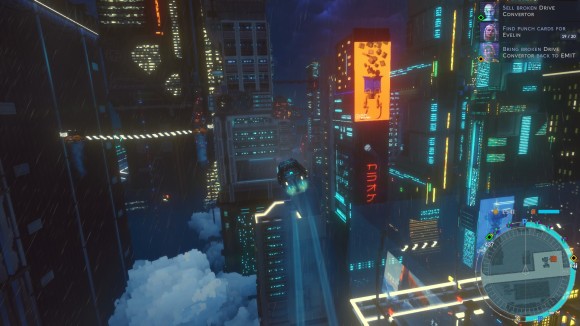
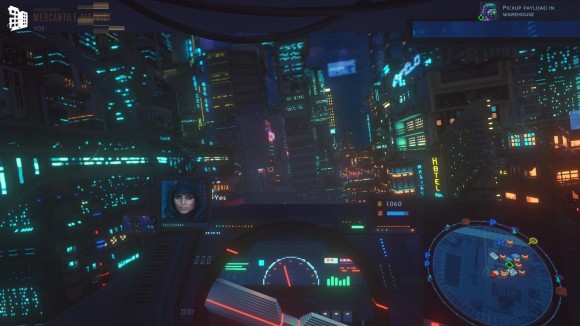
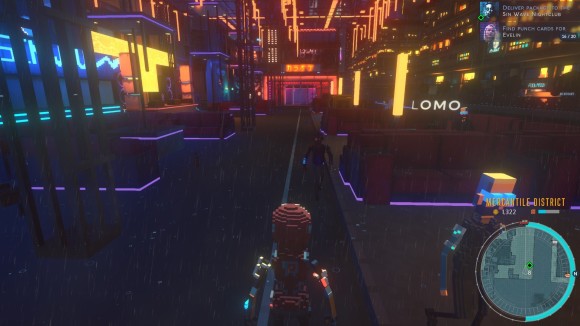
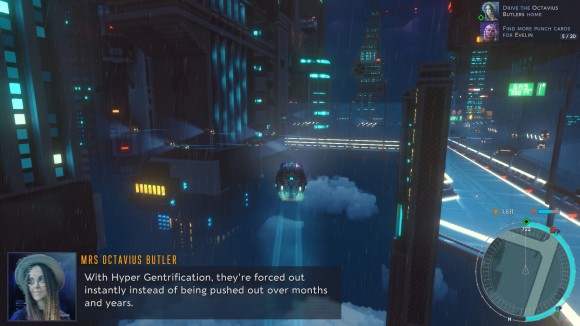
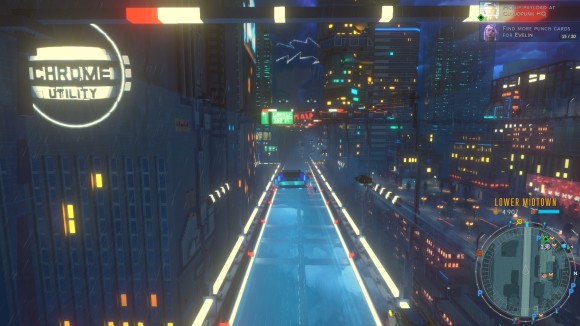
Interesting! I agree with most of the review including quality and length of story; but I played it when it came ou t and you could only play the ground portions from distant 3rd person perspective. Graphics were more than adequate from that angle and I would’ve sorely missed the NPCs which made the city seem bustling. I think Devs fought a long hard battle against introducing first person mode, and it looks like they shouldn’t have ultimately succumbed ????
I played the ground sections in 3rd person. It’s not really a look thing, it’s more that there’s nothing to do in the ground sections other than run around picking up punch cards and having those insufferable conversations with the rando NPCs. The NPC walk behaviour is fine if it’s just providing a backdrop for some meaningful player activity, but it feels like the ground sections are just there for you to spend a lot of (enforced) time looking at, and that makes it incredibly easy to see the seams even in Ubisoft games — I’m playing through AC Valhalla right now, and if you examine any portion of its open world for more than five seconds you can see a lot of patently ridiculous things going on. Unfortunately because that’s all I do in Cloudpunk, the seams are all I can see.
As Nikola says, I played just after release and didn´t see any problems with the pedestrian parts in the graphics front.
The overall arch and the particular mission stories seem little more than an excuse to drive around, though. It worked for me because of the general atmosphere, but I can see how it can easily become a chore for others.